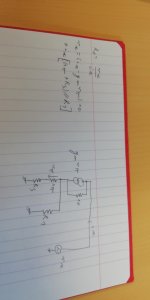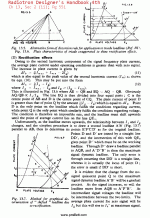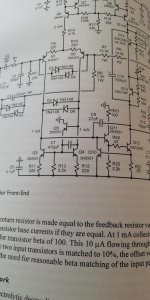I know about that is the impedance looking into collector, could you developp, because my reasoning doesn't seem correct?Small signal analysis. Rout is the impedance looking into the collector of Q1.
Attachments
Might as well use a 6.3WVDC electrolytic capacitor to drop the impedance at the current source base even lower, at audio frequencies. If low is good then lower is better.
Thumbs up to that!

I know about that is the impedance looking into collector, could you developp, because my reasoning doesn't seem correct?
You are on the right track... just finish solving the 2nd equation...
v_pi = - r_pi*(R1 / (r_pi + Rs)*i_x)
Replacing v_pi into your 2nd equation, all the terms on the RHS are a function of i_x.
Now solve for ro = v_x / i_x as in your first equation, do some simplications like I showed a few posts back, and you are done.

That is correct. That circuit is only one of many ways to implement a current source, and was just illustrated as a way to teach the concepts.
Cheers,
Bob
I understand. I am now teaching concepts (along with Mark Johnson's post) on other implementations from the perspective of Rout which was Jerome's original question.
By the way Bob, you forgot to get back to me on "Hi Bob, not sure if you have seen my little video channel hobby project. If you have not, take a peek (it is in my signature), I take feedback... just don't criticize the audio in the first 2 videos... I already got enough flak for that."
Rick Savas and Hugh Dean gave me their
 , but also wanted to get your feedback. If you don't want to do it in a public thread, you can just PM me.
, but also wanted to get your feedback. If you don't want to do it in a public thread, you can just PM me.Thanks!
....high power pro audio amps .... is there something very different.....?
Aside from cost and system factors encouraging more complicated amplifiers....
The real key to a "PRO" amp is that you can not kill it. (Not all amps in the pro shop meet this goal.) Gross over-drive, mis-matched speakers, weird squeals from weird musicans... the show goes on, tonight and tomorrow and all through a tour.
The old Mac and Bogen and Altec tube PA amps, some Mac and Altec hi-power transistor amps, and notably the Crown DC-300: they were beefy enough not to be hurt by bad signals in bad loads, or their protection system limited their output AND (preferably) flashed a light so you knew which amp in the rack was in distress.
Aside from cost and system factors encouraging more complicated amplifiers....
The real key to a "PRO" amp is that you can not kill it. (Not all amps in the pro shop meet this goal.) Gross over-drive, mis-matched speakers, weird squeals from weird musicans... the show goes on, tonight and tomorrow and all through a tour.
The old Mac and Bogen and Altec tube PA amps, some Mac and Altec hi-power transistor amps, and notably the Crown DC-300: they were beefy enough not to be hurt by bad signals in bad loads, or their protection system limited their output AND (preferably) flashed a light so you knew which amp in the rack was in distress.
But besides protection, is there anything fundamentally different about them?
Last edited:
The right formula is not v_pi = - r_pi*(R1 / (r_pi + Rs+R1)*i_x), current divider rule must include R1 at the denominator?v_pi = - r_pi*(R1 / (r_pi + Rs)*i_x)
I understand. I am now teaching concepts (along with Mark Johnson's post) on other implementations from the perspective of Rout which was Jerome's original question.
By the way Bob, you forgot to get back to me on "Hi Bob, not sure if you have seen my little video channel hobby project. If you have not, take a peek (it is in my signature), I take feedback... just don't criticize the audio in the first 2 videos... I already got enough flak for that."
Rick Savas and Hugh Dean gave me their, but also wanted to get your feedback. If you don't want to do it in a public thread, you can just PM me.
Thanks!
Hi Sandro,
I looked at the fundamentals video this evening and I think it is very good. You cover a lot of ground and explain quite well. The only place I got tripped up a little bit was your discussion of the half wave distortion mechanism. I knew where you were going with this, and everything you said was correct, its just that I never thought of the generation of even harmonic distortion as originating from a hard half wave process. I usually think of even harmonic distortion as resulting from incremental gain being higher with positive swings and less with negative swings, or vice versa. Obviously, that is extremely true of half wave rectification
Cheers,
Bob
Hi Bob, thanks for the comments, I greatly appreciate your kind words. I decided to venture into this video series project to show the material in a different format, basically a lecture/conference format while adding my own spin on the topics based on my experience at ADI. I am glad you liked the distortion fundamentals video.
Anyway, thanks again and keep tuned for more.
Best, Sandro
That is exactly right. If you take it to one extreme, like in the half-wave rectification where the negative gain is 0, you only get even harmonics. If you take it to the other extreme, where the positive and negative gains are the same, you only get odd harmonics. If you are between both extremes, you get both order harmonics... it is very fascinating.I usually think of even harmonic distortion as resulting from incremental gain being higher with positive swings and less with negative swings, or vice versa. Obviously, that is extremely true of half wave rectification
Anyway, thanks again and keep tuned for more.
Best, Sandro
....I got tripped up... half wave distortion mechanism. ....extremely true of half wave rectification. ....
Note that when plotting loadline on curvy tubes ('50, 6L6) the mid-point changes from idle to full power. The correction is nicknamed "rectification".
Attachments
There is a base width modulation. In my mind, base current stays the same, isn't it?
Just to add to other replies -
the depletion region from the collector-base junction widens as Vcb increases.
Widening into the base reduces the effective base width. A narrower base has a higher gain (if the doping is the same), so no, the base current is reduced to maintain the same collector current.
Consider this: collector current is mostly diffusion from the emitter-base junction.
In physics diffusion is simply where a high concentration wants to move into a lower concentration region.
Diffusion from the emitter in the case of the NPN is electrons. On the emitter side is a load of them. On the collector side, not so many. So if the base is narrower, the concentration gradient is steeper. Leading to a higher current for a nominally the same emitter-base bias.
Last edited:
Just to add to other replies -
the depletion region from the collector-base junction widens as Vcb increases.
Widening into the base reduces the effective base width. A narrower base has a higher gain (if the doping is the same), so no, the base current is reduced to maintain the same collector current.
Consider this: collector current is mostly diffusion from the emitter-base junction.
In physics diffusion is simply where a high concentration wants to move into a lower concentration region.
Diffusion from the emitter in the case of the NPN is electrons. On the emitter side is a load of them. On the collector side, not so many. So if the base is narrower, the concentration gradient is steeper. Leading to a higher current for a nominally the same emitter-base bias.
Good explanation!
Cheers,
Bob
This is very clear. Thank youJust to add to other replies -
the depletion region from the collector-base junction widens as Vcb increases.
Widening into the base reduces the effective base width. A narrower base has a higher gain (if the doping is the same), so no, the base current is reduced to maintain the same collector current.
Consider this: collector current is mostly diffusion from the emitter-base junction.
In physics diffusion is simply where a high concentration wants to move into a lower concentration region.
Diffusion from the emitter in the case of the NPN is electrons. On the emitter side is a load of them. On the collector side, not so many. So if the base is narrower, the concentration gradient is steeper. Leading to a higher current for a nominally the same emitter-base bias.
Just to add to other replies -
the depletion region from the collector-base junction widens as Vcb increases.
Widening into the base reduces the effective base width. A narrower base has a higher gain (if the doping is the same), so no, the base current is reduced to maintain the same collector current.
Good explanation, let me expand a bit more. To generalize:
- If you force IC to be constant (e.g. with a feedback loop of some sort like the one provided by R1 in the current souce). A Delta_VCE results in a Delta_IB and Delta_VBE. Delta_IB reduction is due to the decrease in beta, Delta_VBE = ~Delta_VCE/(gm*ro).
- If you force VBE with a voltage source, with a Delta_VCE then you only get Delta_IC (no delta IB), where Delta_IC = IB X Delta_Beta.
- If you force an IB, with a Delta_VCE you get a Delta_IC only (no delta VBE) where where Delta_IC = IB X Delta_Beta.
Most practical cases lie somewhere between all of these. BJT's are weird...
I hope it helps...
Note: Delta = Change in.
Book Review: Designing Audio Power Amplifiers | Stereophile.com
Reviewed in Sterophile.
I don't think I've seen this cited?
Reviewed in Journal of the Audio Engineering Society, v68 No4, April 2020
Journal of the AES >> 2020 April - Volume 68 Number 4
More a summary than a critical review, but he liked it.
Attachments
- Home
- Amplifiers
- Solid State
- Bob Cordell's Power amplifier book



